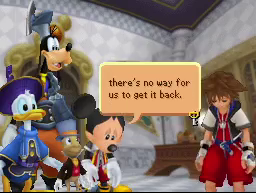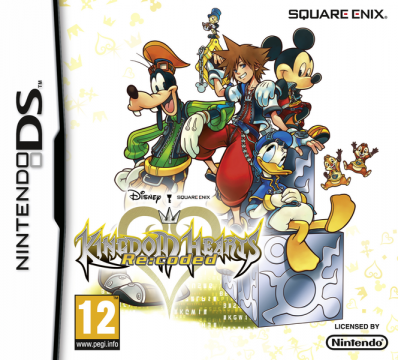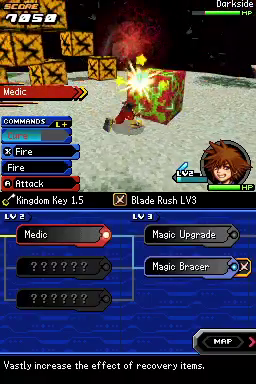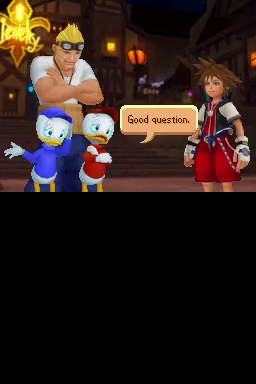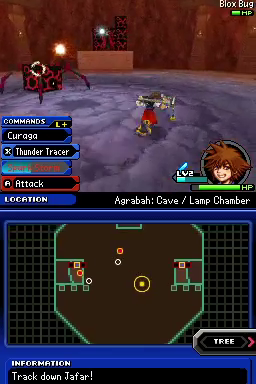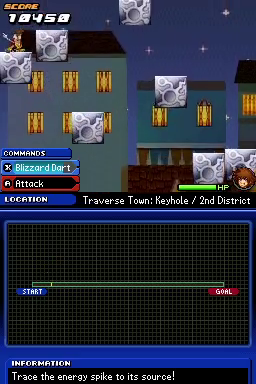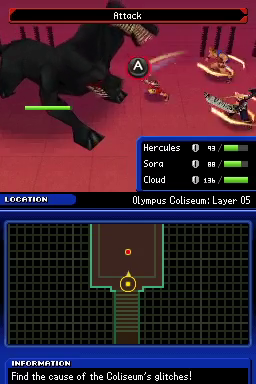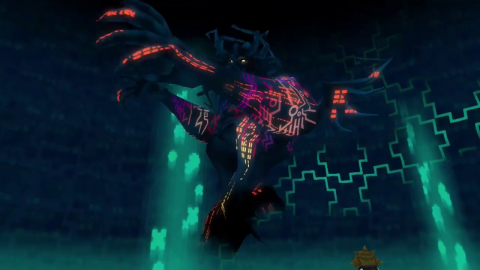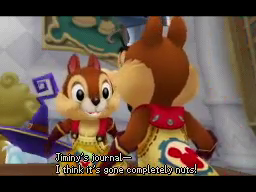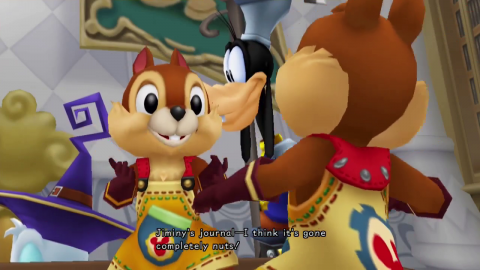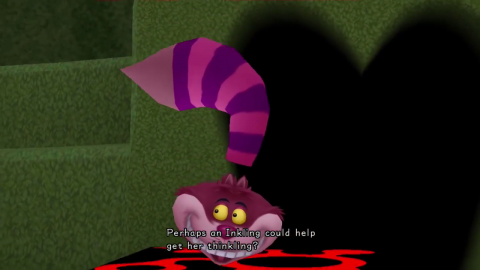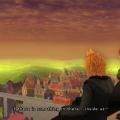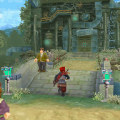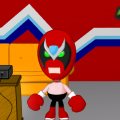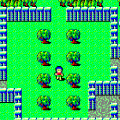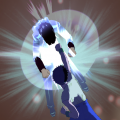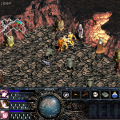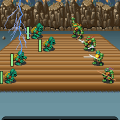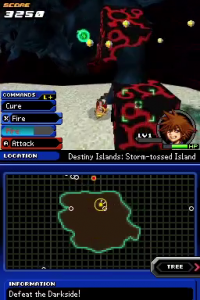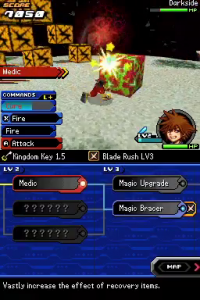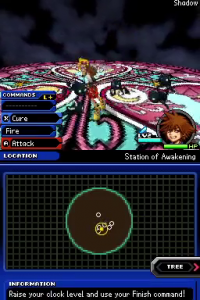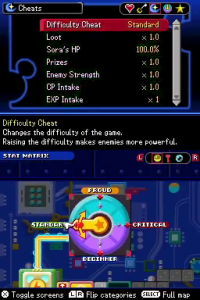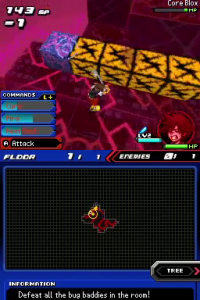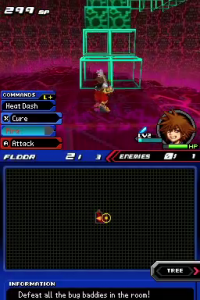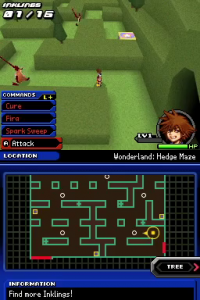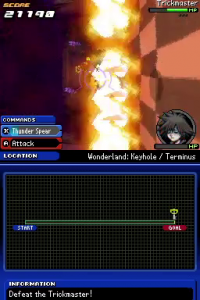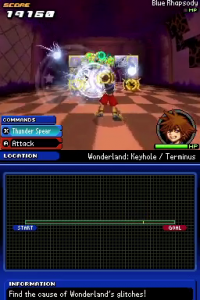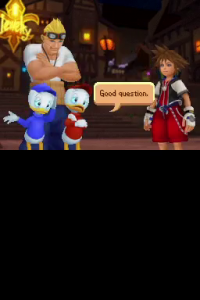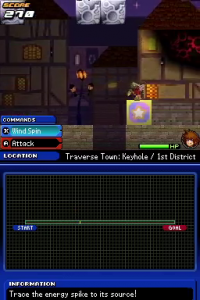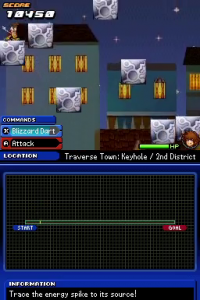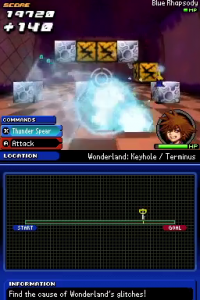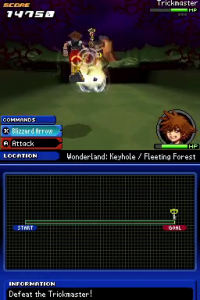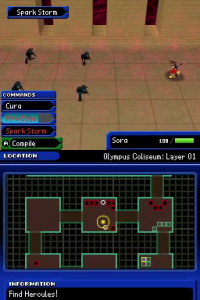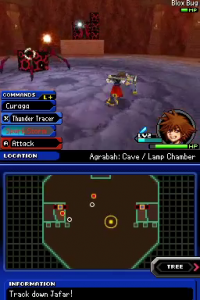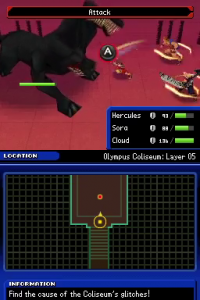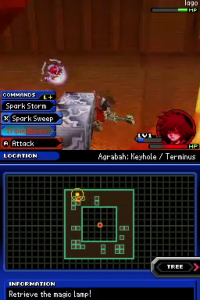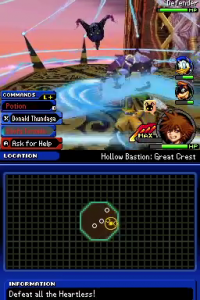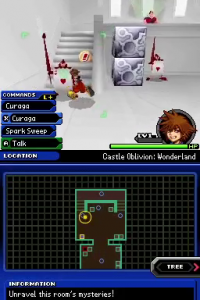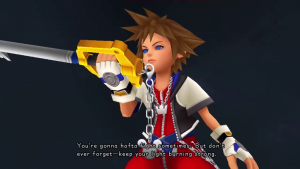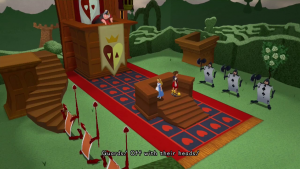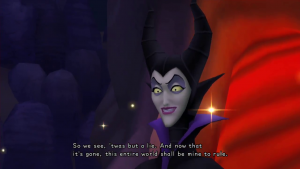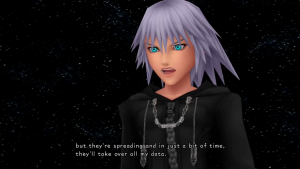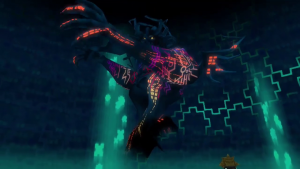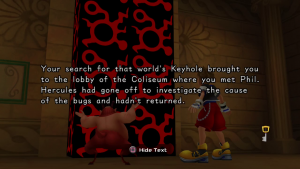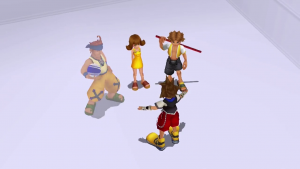- Kingdom Hearts
- Kingdom Hearts: Chain of Memories
- Kingdom Hearts II
- Kingdom Hearts: 358/2 Days
- Kingdom Hearts: Birth By Sleep
- Kingdom Hearts Re:coded
- Kingdom Hearts: Dream Drop Distance
- Kingdom Hearts χ
- Kingdom Hearts 0.2 Birth By Sleep
- Kingdom Hearts III
- Kingdom Hearts: Melody of Memory
- Kingdom Hearts (Miscellaneous)
Kingdom Hearts coded was originally an episodic release, not for the major handhelds, but for Docomo Prime Series-P-01A Panasonic phones exclusively in Japan. The first episode predated 358/2 Days, while the last post-dated Birth by Sleep! A game from the pre-smartphone era, coded is a technological marvel, but the P-01A wasn’t exactly a massive success, rendering the game more obscure than its fellows by degrees. By the time the game actually saw international release, it was as Kingdom Hearts Re:coded for the DS, once again developed by h.a.n.d. But even though the DS version feels like the superior version in most regards, the Docomo version had its high points, and the porting team left behind plenty of good ideas that remain lost on the original platform.
The story is weird, even by Kingdom Hearts standards. Jiminy Cricket (Sora’s diarist, long story) is perusing an old journal that ended up supernaturally blanked when everyone forgot their memories during Chain of Memories, when he discovers a message he never wrote. To help out, Mickey hooks him up with… and it can’t be stressed that this isn’t the first time something like this has shown up in the series, but it hardly helps… a machine that creates an entire digital world inside of the book, based on its contents, which are, to repeat, blank. As a result, we’re maybe not surprised to find that the digital world is filled with “bugs” that prevent them from investigating further. Mickey and pals, they contact a “data” version of Sora from the original Kingdom Hearts, now a simulated AI being, and convince him to adventure on their behalf. Later, a digital version of Riku shows up and… ugh, you wouldn’t believe it.
The original, cell phone version of coded used 3D environments, but pre-rendered, 2D sprites for characters, including most enemies and bosses. The camera only moved laterally over the stage, rarely rotating. The player can move in the eight cardinal directions using the number pad, with other actions varying by model of phone. Combat is standard, save that some of the game’s special attacks involve playing a short QTE sequence to land multiple hits. To help overcome his movement limitations, Data-Sora can learn an early skill that will help him auto-target nearby enemies so that he can attack at other angles. The hardest everyday challenge was getting behind enemies that are invulnerable from the front, because Data-Sora was not quick on his feet.
The most common obstacle created by the “bugs” are the omnipresent “Bug Blox,” which modify recurring Kingdom Hearts maps with new platforming challenges. From time to time, Sora will encounter an even greater glitch and will have to “debug” it. In the early campaign, this often takes the form of a blox-“pushing” puzzle game, where striking a blox causes all adjacent square to fill in, forcing the player to herd them towards the edge of the board, hopefully before they run out of moves. The developers abandoned this recurring puzzle in later episodes, replacing it with novel combat challenges, many, but not all of which were never recreated in the remake, like battles with living blox constructs (the remake only saw one of these, a snake), or various timed challenges.
But the game’s real draw was its genre swaps. In Chapter 2, Sora gets to experience a side-scrolling platformer. Chapter 3’s alternate mode is an over-the-shoulder auto-runner, maybe meant to be reminiscent of Square’s 3D WorldRunner, with its similar checkerboard floors. Sora can shoot beams from his Keyblade in this mode, including lock-on charge shots reminiscent of Panzer Dragoon and the Kingdom Hearts II Gummi mode. The Hercules world gets the apex: the entire world is a turn-based RPG, with allies, timed hits and its own, unique spell systems! That the developers could turn out almost entire new game engines three chapters in a row was remarkable, but they changed gears, and the remaining chapters get gameplay gimmicks instead, including the memorable and perhaps frustrating Chapter 5, where you command Donald and Goofy from the sidelines. The side-scroller makes a return in Chapter 6.
Unfortunately, the lack of time and budget tells on the entire product, despite the impressive base engine. Sora’s animations are smooth, but most enemy and character animations are limited to an extreme. And while the developers’ budget and time constraints arguably justify their heavy asset re-use, it’s still hard to care about the third “rehash game” in the series. Even one of the game’s original selling points, a series of new scenes that fill in parts of the Kingdom Hearts story, stop showing up after a few worlds. One last scene appears estranged from all context in the final world, as though it arrived half a year too late! For what it’s worth, the final world (which eschews the Kingdom Hearts retelling to bring us back to Castle Oblivion) is often regarded as one of Kingdom Hearts‘ best, but for many, it’s too little, too late.
One other thing that has to be noted about the original coded is that it was tied at the hip to Kingdom Hearts Mobile, a tie-in product that will be covered in a later post about spinoffs. coded unlocked wallpapers and avatar parts in Mobile, and Mobile was coded‘s only source of traditional currency for the in-game shops!
Once Kingdom Hearts coded was ported to DS as Re:coded, it adopted 358/2 Days‘ pre-existing, 3D engine, but there was no multiplayer mode this time, and a lot of the technical restrictions and jank were mercifully ditched alongside. The game looks and plays better than 358/2 Days ever dreamed. A few optional features are given to help the player with all the extra platforming in this game, since Kingdom Hearts‘ platforming has never been all that great, but they all come with restrictions that make them less-than-universal improvements, even if they are recommended. For example, the auto-jump feature makes climbing up blox a breeze (just walk off the edge!), but makes it a little harder to go down!
One stylistic change in Re:coded is the way the game chooses to display in-game cutscenes. In the original coded, characters moved around the overworld as they talked, but Re:coded uses a sort of pre-rendered “puppet theater,” where expressions are screenshots created with the limited Kingdom Hearts models. The characters can’t really shake the impression that they’re anything more than cardboard standees propped up on sticks, but they do get bigger and more obvious expressions than the muffled talk sprites in 358/2 Days. This puppet stage is also where spatial relations go to die, but that has a certain laughable charm to it.
Like Birth by Sleep, Re:coded is a Command Deck game, and most of its changes concern how Commands are upgraded. Unlike Birth by Sleep, Commands don’t always merge into new Commands – though you can tell if they will because they’ll be highlighted in yellow. If not, the Commands will merge into a higher-level form of the original, ranging from Level 0 to Level 100 (marked with a crown). The specific, numerical benefits of raising Command levels aren’t documented anywhere online, but it’s clear that they eventually cause more damage, heal more wounds, or other things of that sort, even if the gain isn’t spectacular. Commands can also be temporarily merged using a strange, two-slot system, with the player only committing to the merge after they’ve levelled up enough to allow it.
After Birth by Sleep let players go hog wild with abilities and high-level Commands, Re:coded is not so “monty haul”. Your Command Deck has a total “Memory Limit” that prevents you from equipping too many high-level commands, and Abilities are in limited supply, many powerful Abilities restricted to accessories. But most of your powers will come from the new, upgradeable Keyblades, which make it so even the earliest blades have endgame potential. These blade upgrades affect the Clock Tree, a chart of temporary upgrades that the player “climbs” by defeating enemies in moderate succession. The clock tree can technically be changed on the fly via the touch screen, but that’s not something you’re all that likely to do while Heartless are trying to eat your face.
Easily the biggest addition to the remake are the System Sectors, which replace debug sequences from the original (the novel blox-pushing puzzles and unique combat challenges). These System Sectors are set in randomized maps made up of recurring room types, and Sora has to go on a hunt for upgraded Heartless called “bug baddies”. This process is unbelievably repetitive and has absolutely overstayed its welcome by the end of the game, but isn’t without its merits, especially after the betting system is introduced. By betting your “Sector Points” on various, pre-set stunts and challenges, the player can put their everyday, Heartless-fighting skills to the test, something previous games have never really been interested in (favoring high-challenge bosses, instead). These Sector Points can be used to buy items at the end of each sector, up to and including the game’s final Keyblade from the final, secret, sector.
Thankfully, Re:coded kept the cell phone release’s genre swaps and world gimmicks, but not without a few changes. The biggest changes were to the Hercules turn-based RPG, which incorporates Commands in a novel way where using them creates various RPG spells, plus a set of special power-ups. The player can also revisit the world to play an expanded 15 floor dungeon, and after clearing that (an irritating prerequisite), they can revisit the world again for a full, 30 floor dungeon. Re:coded also added a new WorldRunner sequence in Chapter 6, and its decision to remap the Castle Oblivion segments to resemble facsimiles of the original Disney worlds is inspired.
Like h.a.n.d.’s last game, Re:coded‘s progression system is rather odd. Similar to 358/2 Days, your upgrades come in the form of tiles, but in this case you install them to a circuit board with pre-set slots, with no weird Tetris challenges. Connect the CPUs on the circuit board to various gizmos, and you’ll unlock abilities, Command and Accessory Slots, and most interesting of all, the “Cheats,” which allow you to “hack” the game’s parameters, generally offsetting some benefit with another downside, like reducing Sora’s HP in exchange for increased drop rates.
Kingdom Hearts Re:coded is a very easy game, maybe the easiest in the series by default, but with the System Sector challenges and the Cheats, the player can manage their own challenge level. This factors into the game’s final challenge, which unlocks a post-game scene if you can unlock 20 of the in-game achievements, which aren’t exactly softballs.
In an effort to replicate features from Kingdom Hearts Mobile, Re:coded also features a special “Avatar Menu,” which uses the DS’ Tag Mode feature to unlock additional prizes, all tied to a customizable avatar taken from Mobile. The central feature was the ability to “trade” loosely-customizable dungeon floors, with an exclusive bonus boss (urm… bonus boss recolor) if you collected 100. Like a lot of Tag Mode and StreetPass features, this was an instant flop outside of transit-happy Japan, and remains a millstone around the game’s neck in the present day, when you’d be lucky to find another player using Tag Mode even at a gaming convention, although there are ways to trick the game into cooperating.
Like 358/2 Days, Kingdom Hearts coded was only ported to HD as a “film”. All-in-all, it’s the best of these cutscene compilation, with Mickey reading all the filler text, less filler text overall, and even new combat scenes that replace game battles. Once again, the scenes are cleverly arranged so that they could be cut up and used in a fresh, HD adaptation (it’s probably notable that these scenes erased any and all reference of the System Sectors, and even the alternate gameplay genres!). This version also adds two scenes, one in the post-credits, both foreshadowing later games in the series, making it a must-watch for series die-hards, even if they’ve already played the game.
